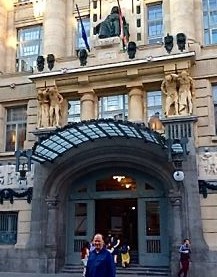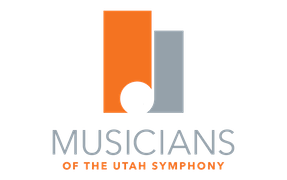The Ring is Completed and a Return Home

Vienna Kiss
Different repertoire for an orchestra allows for certain individuals and certain sections to have their moment in the sun. Playing Wagner showcases the brass, and this was particularly apparent as we completed The Ring Cycle. Unlike our two previous viewings of the operas “Das Rheingold” and “Die Walküre”, this time we had seats inside the Vienna Opera House. Sir Simon Rattle continued on the podium, and the Vienna Philharmonic added their firepower which consisted of augmented sections throughout the brass. Hearing the sound of two tubas on opposite sides of the pit, a full contingent of horns and Wagnerian tubas, four brilliant trumpets, four amazing trombones and heroic offstage horn solos was really thrilling! The voices were powerful and in “Siegfried”, the title character acted and sung by Stephen Gould will be a memory that will last for a long time. His scenes of trying to play a crudely whittled reed-pipe, accompanied by an aching offstage solo English Horn and the famous offstage horn calls were both beautifully timed and convincingly mimed. We marveled at the ability of these singers to sing at full voice for an entire five hours, and with “Götterdämmerung”, five and a half hours! One of the things that we especially noticed was the tremendous applause given to the orchestra at the end of the performance. It was as though the audience understood the musicians had also successfully finished this marathon event. In a way, it felt like it had been an accomplishment for us too. Lisa began planting the idea of seeking out other performances of the Ring. We’ll see.

Parliament Building in Budapest

View of Budapest and the Danube River
We decided to go to Budapest. With just a backpack, we checked in to the Danubius Hotel overlooking the Danube River. Our room on the fourth floor offered a great view of the river teeming with cruise ships, barges and other boats. The Parliament building and the bridges make a big impression, but we were still on a “musical journey” and I was eager to see the Bela Bartok home and museum. Bartok didn’t care for the city, and his home for 11 years was on the outskirts of Budapest. We took the #5 bus to the end of the line and walked a bit through a beautiful quiet neighborhood. Bird calls accompanied us on our walk to a two-story home with a surrounding fence. We were buzzed in through the front gate and soon met “Agnes”. Agnes gave us a tour of the home where Bartok composed “Contrasts”, two string quartets, “Mikrokosmos”, the Music for Strings, Percussion and Celesta, the 2nd Violin Concerto and much more.

Bartok House, with tour guide Agnes
The home contained the original phonograph Bartok used to record more than 8000 folk songs! A topographical map pinpointed the villages Bartok had visited over a 20-plus year period gathering material. A great photograph of him traveling with his phonograph while riding in the back of a rustic wooden cart hangs on one of the walls. Besides the folk songs, Bartok collected regional costumes, folk instruments from various villages, ceramic pitchers and insects. The bugs were on display and were the inspiration for his piano composition, “Mikrokosmos”. The piece was written for his young son, Peter Bartok, and imitates the sounds made by insects. Lisa remembers playing the piece on piano, but seeing the little bugs gave the composition a little more meaning. The dining room furniture was made up of some beautifully handmade pieces from a maker in Transylvania. They were unique and personal. The maker’s photograph hung on the wall along with family and friends, including Zoltan Kodaly.

Bartok’s home
Many of the photographs show Bartok with a cigarette in hand and it would be lung disease that would cause his death in a New York hospital at the age of 65. The home was a popular place for musical gatherings during Bartok’s lifetime and an attractive recital space is still used today. Lisa bought some Bartok flute compositions that the museum had for sale. Somehow, knowing Bartok as a human being gives us a stronger feeling for his music. We both look forward to performing his music again.

Liszt Academy of Music
One of the more important and most beautiful music schools in Europe is the Franz Liszt Academy of Music in Budapest. Notable alumni include Bela Bartok, Antal Dorati, Zoltan Kodaly, Gyorgy Ligeti, Eugene Ormandy, Fritz Reiner, Janos Starker, Georg Solti and many more. We were aided by a young violinist, O’sz Puspoki Dorottya, from the neighboring high school conservatory in finding the Academy just in time to attend a free vocal recital by Zsofia Stasny. We enjoyed different aspects of the recital, but were distracted by the beauty of the concert hall. The Art Nouveau style is one of the best examples in all of Europe. One recital seemed like it didn’t offer enough time to take in all there was to see. We lingered after the applause died down, giving us time to enjoy the view.

Liszt Hall
The next day we enjoyed the beautiful spa connected to Hotel Danubius. There was a feeling that many of the Hungarian people using the spa did so on a regular basis. Those tans probably don’t happen sitting on the couch at home!
We returned by train to Vienna in time to hear the City of Birmingham Symphony Orchestra conducted by one of our favorites, Andris Nelsons. The program featured the Mozart Violin Concerto in D with Baiba Skride, who has played with us in Utah several times. Her playing had style and some expressive use of dynamics. The orchestra did a great job too. In the second half, we heard the Bruckner 7th Symphony. There was some excellent string and brass playing, and the audience expressed their appreciation long after the final fortissimo chord.
We enjoyed spending more time with Alexandra Turk from the University of Music and Performing Arts in Vienna. Her work with physiology and musicians takes her to many important cities, and her stories of life in St. Petersburg were especially entertaining. She also has a discerning ear, and her musical opinions often matched our own.

Danube River
After having enjoyed being on canal, river and boat rides many times previously in Europe, we decided on taking a “three-hour tour” on the Danube River aboard the “Blue Danube”. My childhood memories of TV and the tales of the crew of the S.S. Minnow being shipwrecked on “Gilligan’s Island” were quite different from this three-hour cruise. Our time on board the Blue Danube allowed us opportunities to see how a lock system operates, to take in another beautiful city from a different perspective, eat a delicious lunch and perhaps see graffiti in another way. In Vienna there seems to be an encouragement of graffiti art along the banks of the Danube River. Much of it I would describe as both colorful and creative. I took pictures and sent them to my son in New York City. It’s good to have a second opinion! People might ask whether the Danube is indeed blue? I’d probably say it’s more a muddy sage green, but “The Muddy Sage Green Waltz” by Strauss doesn’t have the same kind of ring! He probably was thinking about marketing.

George Solti statue

Graffiti along the Danube
It’s been suggested that we’ll experience “culture shock” upon returning to the States after three months in Europe. We imagine missing the experiences of Europe, the concerts, afternoon “kuchen” at an outdoor café, the architecture, pedestrian-friendly streets and plazas, the cobblestone charm, etc., but coming home can be nice. There is family, friends, peanut butter, tacos, ice cubes, TV in English, the English language, not living out of a suitcase, smoke-free environments, the Farmers Market, a familiar pillow and ….. I could use a haircut! We’ll look back and smile at having seen “Duck Dynasty” dubbed in German, or seeing the word “Geschwindigkeitsbegrenzung”, which I learned means speed limit in German or reviewing the hundreds of photographs taken in nine amazing countries.
The plane touched down safely in Salt Lake City. We have a nephew’s wedding coming up and Lisa soon heads to Arcata, California to teach at the Sequoia Chamber Music Workshop. I go for a month to Sewanee, Tennessee where I hope to make a difference for twelve young oboe players. For any musician, it’s a lot about the journey, and being “on the road” has many rewards. We always look forward to what’s next. Next for me will be a month on a mountain in Tennessee and what might be one of the more intense musical experiences in America. Stay tuned!

Tucker Weathers, Colleen Hampton Weathers, Lisa and Bob
– Robert Stephenson and Lisa Byrnes
